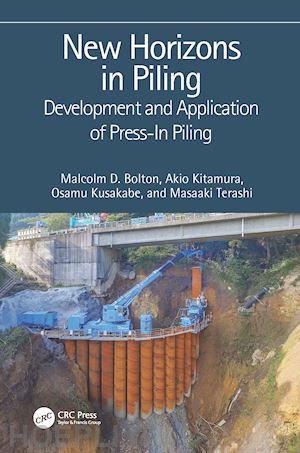Malcolm Bolton graduated in Engineering from Cambridge University in 1967 and subsequently took an MSc by research in structural engineering from Manchester University and a PhD in soil mechanics from Cambridge University. His career in geotechnical engineering started in Manchester (at UMIST) in 1969 where he helped Andrew Schofield to develop the UK’s first geotechnical centrifuge. He became a Lecturer in 1970 and stayed a further 10 years at UMIST, publishing his book “A guide to Soil Mechanics” in 1979. He returned to Cambridge in 1980, ultimately becoming Professor of Soil Mechanics, Director of the Schofield Centre for Geotechnical Process and Construction Modelling, and Head of the Geotechnical and Environmental Group in the Department of Engineering. In accordance with University Statutes he retired in 2013. He is the author of over 240 publications covering the fundamental mechanics of granular materials and a wide variety of civil engineering applications from tunnels through foundations, and from earthquake effects to landslide hazard reduction. Akio Kitamura started his business in the construction industry in 1967 dealing with piling contracts for foundation works using construction machinery such as the vibratory hammer. Experience of unexpected adverse impact of his own business on the environment, he decided to devote himself to inventing and developing pollution-free piling machines. In 1975, he invented a press-in piling machine, the "Silent Piler", which installs a pile into the ground by hydraulic jacks while gaining reaction force by gripping the previously installed piles. He continued efforts to reduce the size and weight of the piling machine, and in a few years he added "Self-walking function" to the piler. The self-walking means that a crane is no longer required for relocating and positioning the machine to install the next pile. These “Grip” and “Self -Walking” functions have further extended to the idea of the so-called "non-staging system", where all the necessary piling work procedures, including pile transportation, pile pitching and press-in operations can be carried out on the top of the aligned installed piles. The first application of the non-staging system was used in 1986, only 10 years after his initial invention of the Silent Piler. Mr. Kitamura has received various awards and Prizes including The Order of the Rising Sun, Gold Rays with Rosette. Most recently he was awarded the Ben C. Gerwick Award from the US Deep Foundations Institute. Osamu Kusakabe graduated in 1973 from the Tokyo University of Agriculture and Technology, he obtained a Master of Engineering from the Tokyo Institute of Technology in 1975. He became a Research Associate of the Tokyo Institute of Technology in 1975. He then went to UK and obtained a Master of Philosophy and a Doctor of Philosophy both from Cambridge University in 1980 and 1982, respectively. After he returned to Japan, he became an Associate Professor of Utsunomiya University in 1984, and a Professor of Hiroshima University in 1991. He returned to the Tokyo Institute of Technology as a Professor in 1996. During these years, he also served as an Overseas Fellow of Churchill College at Cambridge University in 1990, a Distinguished Visiting Professor at National University of Singapore in 1998 and a Visiting Scientist at Delft University of Technology in 2004. Throughout his academic career, he continuously engaged in research on geotechnical centrifuge modeling, bearing capacity of foundation and design of geotechnical structures, publishing more than 150 papers. He launched the International Journal of Physical Modelling in Geotechnics in 2001 (presently included in ICE Virtual Library) and served as the Founding Editor-in-Chief of the Journal for ten years. He has played an important role at various organizations including the Founding Secretary General of the Asian Civil Engineering Coordinating Council (1999 – 2001) , the President of the Japanese Geotechnical Society (2010-2012), the Vice president of the Japan Society of Civil Engineers (2008- 2010), the President of Japan Section of American Society of Civil Engineers (2009 -2011), a Board member of the International Society for Soil Mechanics and Geotechnical Engineering (2005-2009), an Associate member of the Science Council of Japan (2005-2013). He was also involved in various committees including a member of the International Advisory Board for the Singapore Land Transport Authority, and a member of the technical committee on Honshu-Shikoku Bridges.Osamu Kusakabe served as the Chair of the Executive Committee of the Asian Civil Engineering Coordinating Council (2017-2019). He is currently the President of the International Press-in Association since 2016. In April 2011, he became the Emeritus Professor of the Tokyo Institute of Technology and of the National Institute of Technology, Ibaraki College in June 2016, where he was the 9th President (2011-2015). He is currently the












